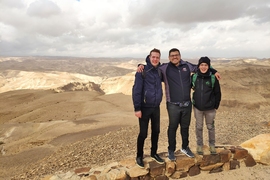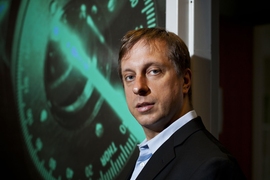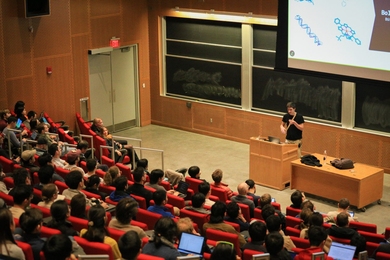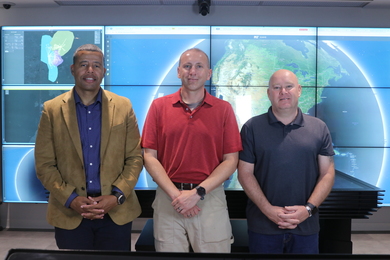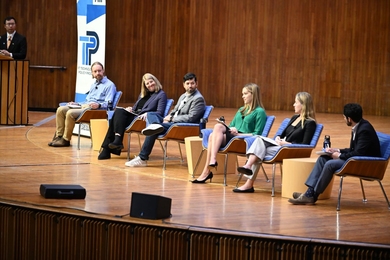MIT Professor Marin Soljačić and four additional MIT alumni — Vanderlei Salvador Bagnato PhD '87, Turan Erdogan '87, Harold Metcalf ’62, and Andrew Weiner '79, SM '81, ScD '84 — are among 17 recipients of the 2023 Optica Awards.
Optica, formerly known as OSA, announced the awards, which celebrate those in the optics and photonics field who are making significant technical, research, education, business, leadership, and service accomplishments.
Soljačić '96 received the Max Born Award, which recognizes outstanding contributions to physical optics, theoretical or experimental, “for seminal contributions to the fields of plasmonics, electromagnetism, and topological photonics.”
Soljačić's research focuses on optics and photonics, specifically nanophotonics and nonlinear optics, as well as on intersections between AI and physics. His research on electromagnetic waves is unveiling fundamental principles of optical physics, such as switches for optical computers and wireless power transmitters. By using strongly coupled magnetic resonances to wirelessly transfer power, his work may help enable wireless recharging for laptop computers, cell phones, and electric vehicles.
His nanophotonics research also investigates how to control light interactions with materials that are structured at the nanometer scale. His progress on photonic crystals, which can alter the behavior of light, is promising to help improve the efficiency of solar and thermal energy conversion, speed up optical communications, and improve applications that use lasers, LEDs, and optical fibers.
Such applications use “metamaterials” featuring nanoscale structures made of a lattice of one kind of material alternating with either a different material or open space; metamaterials can for example be designed to let certain wavelengths pass through while reflecting or absorbing others. Such materials can, among other applications, be designed to absorb substantially more solar energy.
He is also adding arrays of wave-like ridges and other nanoscale-level configurations onto the surface of scintillating materials, which emit light when bombarded with high-energy particles or X-rays, to radically boost the precision and reach of medical X-ray systems, night-vision tools, particle detectors, and electron microscopes.
“Few scientists accomplish so much, in so many different aspects of science, with as much impact as Marin has had,” says Professor Erich P. Ippen ’62, a principal investigator in the Research Laboratory of Electronics (RLE). “An award named after Max Born who also had such a broad impact is especially fitting.”
A native of Zagreb, Croatia, Soljačić majored in physics and electrical engineering at MIT, with an undergraduate thesis on inflationary cosmology, co-written with physics professors Alan Guth and Lisa Randall. He pursued his master's degree at Princeton University, working with now-MIT Professor Frank Wilczek on soft condensed matter theory, which studies the physical behavior of materials such as liquids, glasses, polymers, foams, and gels. His PhD thesis at Princeton, done under the supervision of Professor Mordechai Segev, focused on nonlinear optics.
Soljačić returned to MIT as a Pappalardo Fellow in 2000, and was a principal research scientist in the RLE before joining the physics faculty in 2005. Among other awards, he is a recipient of a MacArthur "genius" Fellowship, the Blavatnik National Award, and the Adolph Lomb Medal. He is an international member of the Croatian Academy of Engineering, and he received the Croatian President’s top medal for Science, The Order of the Croatian Daystar, and was also awarded the Order of the Croatian Interlace medal. He is also a founder of WiTricity Corp., Lux Labs, and Lightelligence.
Vanderlei Salvador Bagnato PhD '87 of the University of São Paulo - Instituto de Fisica de Sao Carlos in Brazil and a professor of biomedical engineering at Texas A&M University, received the Robert E. Hopkins Leadership Award “for outstanding contributions to the global impact of optics and photonics and for promoting the field to the general public worldwide.” Bagnato received his master's degree in physics from the University of São Paulo and his PhD in physics from MIT. He works in the fields of optics, atomic, and molecular physics with cold atoms and biophotonics. In atomic physics, he is a pioneer in the production of cold atoms, and his main contributions rely on experiments with Bose-Einstein condensation, quantum turbulence, and the production of the first atomic clock in Latin America. In biophotonics, he has made influential contributions to the use of photodynamic action for the treatment of cancer and microbiological control, including antibiotic-resistant infections. The Hopkins Leadership Award recognizes an individual or group who has had a significant impact on the global optics and photonics community, or on society as a whole stemming from non-research-oriented activities.
Turan Erdogan '87, the president of Plymouth Grating Laboratory, received the David Richardson Medal for his contributions to the commercial development of optical components and technologies “through remarkable entrepreneurship and business acumen leading to products and applications in numerous areas including optical fiber systems, medical optics, and femtosecond laser technology.” Erdogan received his BS in physics and EECS from MIT and his PhD from the University of Rochester, and was an AT&T Bell Labs postdoc. He previously was site leader for Melles Griot, USA; CTO and VP of business development for IDEX Optics and Photonics and IDEX Health and Science; co-founded Semrock, Inc., which was acquired by IDEX; and a tenured professor at The Institute of Optics at the University of Rochester. Established in 1966, the Richardson Medal recognizes significant contributions to optical engineering, primarily in the commercial and industrial sector.
Physics alumnus Harold Metcalf ’62, a professor at Stony Brook University, received the Esther Hoffman Beller Medal for outstanding mentorship of undergraduate students in hands-on optics research, and for organizing an annual symposium for students to present their work during the FiO/LS conference. His research is focused on optical control of atomic motion, and he was one of the leaders in the earliest experiments of laser cooling and trapping. Metcalf has published three textbooks, including "Laser Cooling and Trapping."
The Beller Medal is presented for outstanding contributions to education in optical science and engineering.
Purdue University Professor Andrew Weiner '79, SM '81, ScD '84 received the Charles Hard Townes Medal for “ground-breaking work bringing optical frequency combs to the quantum world and developing innovative applications spanning several fields, including coherent control, generation and line-by-line manipulation of frequency combs, and ultra-broadband radio-frequency photonics.” Weiner earned several EECS degrees from MIT, and is the Scifres Family Distinguished Professor of Electrical and Computer Engineering at Purdue. He worked at Bellcore as a technical staff member and as manager of Ultrafast Optics and Optical Signal Processing Research. He has also spent sabbaticals at the Max Born Institute for Nonlinear Optics and Ultrashort Pulse Spectroscopy, Germany; JILA, University of Colorado; and the National Institute of Standards and Technology. The Townes Medal, which recognizes an individual or group for outstanding experimental or theoretical work, discovery, or invention in the field of quantum electronics, honors Charles Hard Townes, whose pioneering contributions to masers and lasers led to the development of the field of quantum electronics.


